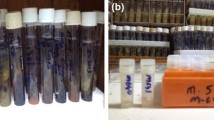Abstract
The aim of this study was to evaluate the morphological and biochemical characteristics of yeasts during storage. SixCandida spp. standard strains were stored in agarized medium with mineral oil in distilled water, frozen at −70°C and freeze dried. Strains were phenotypically characterised before being stored and then periodically for up to 18 months. Randomly Amplified Polymorphic DNA (RAPD) was carried out in time zero, 6, 12 and 18 months of storage. The viability of all samples was preserved except for the strain ofCandida dubliniensis after 12 months of storage with mineral oil. No phenotypic alterations were observed in any of the methods employed. However, variations were observed in some phospholipase or proteinase activities. Changes in the RAPD patterns were not detected. These results seem to indicate that the maintenance methods tested were able to preserve the stability of the yeast phenotypic and genotypic characteristics.
Similar content being viewed by others
References
Abadias M., Teixidó N., Usall J., Benabarre A., Viñas I. (2001). Viability, efficacy, and storage stability of freeze-dried biocontrol agentCandida sake using different protective and rehydration media. J. Food Prot., 64: 856–861.
Ashcar H., Paula C.R., Petrocini V.R. (1988). Manutenção de fungos por processo de liofilização após período prolongado de tempo — 34 anos. Rev. Microbiol., 19 (4): 422–424.
Bauer D., Müller H., Reich J., Riedel H., Ahrenkiel V., Warthoe P., Strauss M. (1993). Identification of differentially expressed mRNA species by an improved display technique (DDRT-PCR). Nucleic Acids Res., 21 (18): 4272–4280.
Candido R.C., Azevedo R.V.P., Komesu M.C. (2000). Enzymotiping of species of the genusCandida isolated from the oral cavity. Rev. Soc. Bras. Med. Trop., 33(5): 437–442.
Crespo M.J., Abarca M.L., Cabañes F.J. (2000). Enzymotiping of species of the genusCandida isolated from the oral cavity. Rev. Soc. Bras. Med. Trop., 33 (5): 437–442.
Crespo M.J., Abarca M.L., Cabañes F.J. (2000). Evaluation of different preservation and storage methods forMalassezia spp. J. Clin. Microbiol., 38 (10): 3872–3875.
Girão M.D., Prado M.R., Brilhante R.S.N., Cordeiro R.A., Monteiro A.J., Sidrim J.J.C.,et al. (2004). Viability ofMalasseizia pachydermatis strains maintained in various storage mediums. Rev. Soc. Bras. Med. Trop., 37 (3): 229–233.
Kawamura S., Murakami Y., Miyamoto Y., Kimura K. (1995). Cryopreservation and freeze-drying protocols. Freeze-drying of yeasts. Methods Mol. Biol., 38: 31–37.
Kirsop B.E., Snell J.J.S. (1984). Maintenance of Microorganisms, a Manual of Laboratory Methods. Academic Press, London.
Kurtzman P.C., Fell J.W., Eds (1998) The Yeasts: A Taxonomic Study, 4th edn., Elsevier Science B.V. Amsterdam.
Lehmann P.F., Lin D., Lasker B.A. (1992). Genotypic identification and characterization of species and strains within the genusCandida by using Random Amplified Polymorphic DNA. J. Clin. Microbiol., 30 (12): 3249–3254.
Lima R.F., Brito M.M.S., Schäffer G.M.V., Lima O.C., Borba C.M. (2004). Evaluation of thein vitro andin vivo dimorphism ofSporothrix schenckii, Blastomyces dermatitidis andParacoccidiodes brasiliensis isolates after preservation in mineral oil. Can. J. Microbiol., 50: 445–449.
Mardegan R.C., Klein M.I., Gouvêa M.B., Rodrigues J.A.O., Gonçalves R.B., Höfling J.F. (2006). Biotyping and genotypic diversity among oralCandida albicans strains from caries-free and caries-active healthy children. Braz. J. Microbiol., 37: 26–32.
Mariano P. de L.S., Milan E.P., da Matta D.A., Colombo A.L. (2003).Candida dubliniensis identification in Brazilian yeast stock collection. Mem. Inst. Oswaldo Cruz, 98 (4): 533–538.
McLellan M.R., Day J.G. (1995). Cryopreservation and freeze-drying protocols. Introduction. Methods Mol. Biol., 38: 1–5.
Mello A.S.A., Almeida L.P., Colombo A.L., Briones M.R.S. (1998). Evolutionary distances and identification ofCandida species in clinical isolates by Randomly Amplified Polymorphic DNA (RAPD). Mycopathologia, 142: 57–66.
Mendes da Silva A.M., Borba C.M., Oliveira P.C. (1994). Viability and morphological alterations ofParacoccidioides brasiliensis strains preserved under mineral oil for long periods of time. Mycoses, 37: 165–169.
Novak A., Vágvölgyi C., Emödy L., Pesti M. (2004). Characterization ofCandida albicans colony morphological mutants and their hybrids by means of RAPD-PCR, isoenzyme analysis and pathogenicity analysis. Folia Microbiol., 49 (5): 527–533.
Odds F.C. (1991). Long term laboratory preservation of pathogenic yeasts in water. J. Med. Vet. Mycol., 29: 413–415.
Pesti M., Vagvolgyi C.S., Papp T., Nagy A., Novak A. (2001). Variation of isoenzyme and RAPD patterns inCandida albicans morphological mutants with altered colony ultrastructure. Acta Biol. Hung., 52 (2–3): 289–298.
Pinto M.P., Resende M.A., Koga-Ito C.Y., Tendler M. (2004). Genetic variability analysis among clinicalCandida spp. isolates using Random Amplified Polymorphic DNA. Mem. Inst. Oswaldo Cruz, 99 (2): 147–152.
Price M.F., Wilkinson I.D., Gentry L.O. (1982). Plate method for detection of phospholipase activity inCandida albicans. Sabouraudia, 20: 7–14.
Qiangqiang Z., Jiajun W., Li L. (1998). Storage of fungi using sterile distilled water or lyophilization: comparison after 12 years. Mycoses, 41 (5–6): 255–257.
Ruchel R., Tegeler R., Trost M. (1982). A comparison of secretory proteinases from different strains ofCandida albicans. Sabouraudia, 20: 233–244.
Rustchenko-Bulgac E.P., Howard D.H. (1993). Multiple chromosomal and phenotypic changes in spontaneous mutants ofCandida albicans. J. Gen. Microbiol., 139: 1195–1207.
Samaranayake L.P., Raeside J.M., MacFarlane T.W. (1984). Factors effecting the phospholipase activity ofCandida albicans in vitro. Sabouraudia, 11: 201–207.
Sansinforiano M.E., Rabasco A., Martínez-Trancón M., Parejo J.C., Mendoz M.H., Padilla J.A. (2001). Optimización de las condiciones RAPD-PCR enCandida spp. yCryptococcus spp. Rev. Iberoam. Micol., 18: 65–69.
Santos I.M., Abrunhosa L., Venâncio A., Lima N. (2002). The effect of culture preservation techniques on patulin and citrinin production byPenicillium expansum. Lett. Appl. Microbiol., 35: 272–275.
Sanz P., Josebe-Unzaga M., Gallego L., Pujana I., Lopez-Otsoa F., Ezpeleta C.,et al. (1998). Genetic typing by PCR of isolates ofCandida albicans obtained in a resuscitation unit. Enferm. Infecc. Microbiol. Clin., 16 (1): 9–13.
Spencer J.F., Spencer D.M. (1996). Maintenance and culture of yeasts. Methods Mol. Biol., 53: 5–15.
Williamson M.I., Samaranayake L.P., MacFarlane T.W. (1986). Phospholipase activity as a criterion for biotypingCandida albicans. J. Med. Vet. Mycol., 24: 415–417.
Author information
Authors and Affiliations
Corresponding author
Rights and permissions
About this article
Cite this article
Mariano, P.d.L.S., Gonçalves, R.B. & Höfling, J.F. Storage procedures for yeast preservation: phenotypic and genotypic evaluation. Ann. Microbiol. 57, 461–465 (2007). https://doi.org/10.1007/BF03175090
Received:
Accepted:
Issue Date:
DOI: https://doi.org/10.1007/BF03175090




